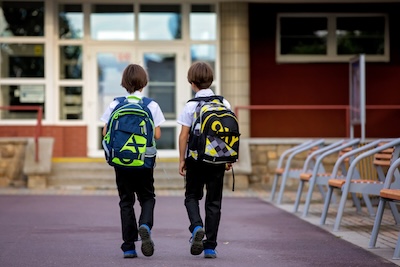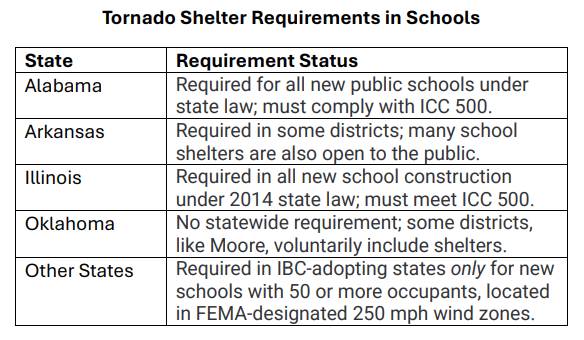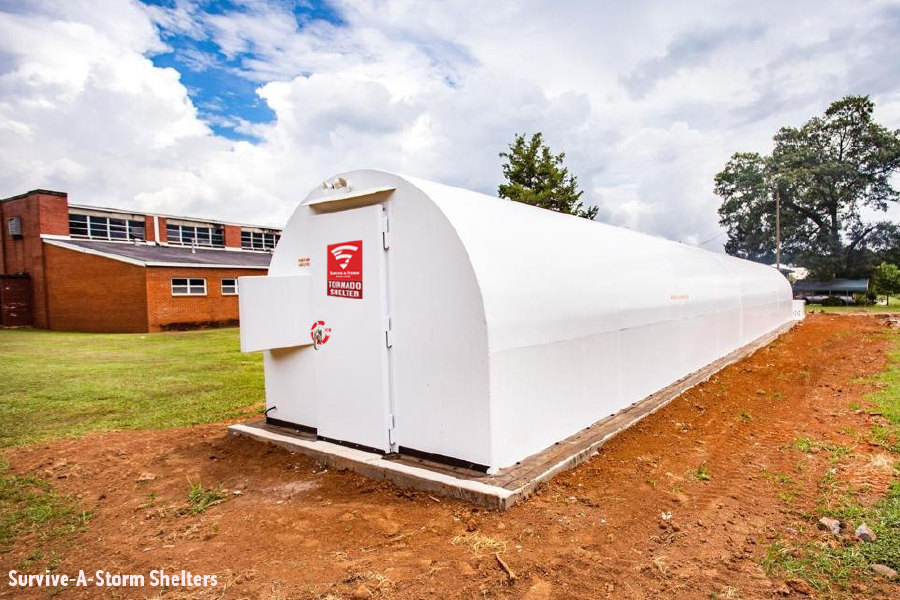CATEGORIES:
Do Schools Need Tornado Shelters? A Complete Safety and Compliance Guide
June 20, 2025

Why Tornado Shelters Are More Than a Legal Requirement
 Tornado shelters in schools aren’t just about checking a legal box; they are a life-or-death safeguard for students, staff, and the wider community. The U.S. experiences around 1,000 tornadoes each year, the highest frequency globally, resulting in hundreds of injuries and dozens of fatalities. In 2024 alone, tornadoes injured 546 people and killed 47, with Texas and Oklahoma accounting for 44% of injuries nationwide.
Tornado shelters in schools aren’t just about checking a legal box; they are a life-or-death safeguard for students, staff, and the wider community. The U.S. experiences around 1,000 tornadoes each year, the highest frequency globally, resulting in hundreds of injuries and dozens of fatalities. In 2024 alone, tornadoes injured 546 people and killed 47, with Texas and Oklahoma accounting for 44% of injuries nationwide.
For schools, where children are among the most vulnerable members of society, the duty of care extends beyond compliance. It's an ethical imperative to ensure robust sheltering options are in place because when disaster strikes, preparation is the only true defense. “If a tornado strikes a school, there are many safety concerns and vulnerable occupants, and storm shelters can help reduce the impact of wind and flying debris," according to Kaitlin Parramore, Director of Sales for Survive-A-Storm Shelters.
Understanding FEMA, ICC-500, State and Local Tornado Shelter Mandates
Federal, state, and local regulations vary widely, and understanding them is essential to compliance and funding.
- FEMA P-361 defines criteria for design and construction of community safe rooms, including school shelters.
- ICC-500, which is the International Code Council/National Storm Shelter Association’s standard, specifies minimum shelter requirements, like wind resistance, capacity, and structural integrity.
- IBC, or International Building Code, mandates that new K-12 schools in much of the Midwest and South Central U.S. must include a storm shelter.
👉 Key Insight: States like Alabama and Illinois require all new public schools to incorporate shelters to ICC-500 standards. Others leave leave this decision to local districts, resulting in wide variability in protection.

Risk Assessment: Is Your School Really in Tornado Territory?
Think tornado risk is confined to Tornado Alley? Think again. Between 2020 and 2024, every U.S. state except Hawaii experienced at least one tornado. Texas led with 516 tornadoes, followed closely by Illinois at 491, and Iowa at 462 tornadoes.
Noteworthy Tornado Stats:
- In Washington County, Colorado there were 40 tornadoes from 2020-2024. This is notable because the state averages around 50 a year.
- In 2024 alone tornadoes caused $1.6 billion in property damage.
With climate change expanding tornado severity and reach, no region can afford complacency.
The High Cost of Inaction: Liability and Reputational Risks
Ignoring tornado safety exposes schools to devastating consequences, both human and legal. A sobering example is the 2007 tornado at Enterprise High School in Alabama, where eight students died when classroom walls collapsed. In response, Alabama enacted legislation mandating shelters in new schools. It's a tragic lesson no district wants to repeat.
Shelter Design and Placement: What Makes a Tornado Shelter Safe?
 Not every room qualifies as a safe room. School tornado shelters are precision-engineered to withstand 250 mph winds and flying debris.
Not every room qualifies as a safe room. School tornado shelters are precision-engineered to withstand 250 mph winds and flying debris.
Key Design Criteria for School Tornado Shelters:
- Location: Lowest floor, away from windows/open spaces.
- Capacity: Shelter must be within 1,000 feet of any building it is meant to protect.
- Construction: Reinforced concrete or steel with independent structural integrity.
- Accessibility: Must accommodate students/staff with disabilities.
Funding Options: How to Afford a Tornado Shelter Without Busting Your Budget
Tornado shelters can increase building costs by about 30%, but funding options exist:
- FEMA Hazard Mitigation Grant Program: Covers shelters meeting ICC-500 & FEMA P-361 standards.
- State Grants/Bonds: Many states provide aid or bond campaign allowances.
- Community Partnerships: Co-fund public-use shelters with local governments.
💡 Frequently Asked Questions About School Tornado Shelters:
- Can FEMA help fund our school’s shelter?
- Yes, if it meets strict standards.
- Are state grants available?
- The answer varies by state. Check with your state emergency management agency.
- What if we can’t afford a full shelter?
- Consider phased construction or retrofitting existing spaces.
Best Practices: Tornado Drills and Safety Audits Every School Should Run
Even the best shelters won't protect students or staff if no one knows how and when to get there. Regular, school specific tornado drills and safety audits are essential.
Drills and safety procedures should be should be well-rehearsed and include:
- All students, especially those in portable classrooms.
- Accessibility for students or staff with disabilities.
- Clear signage and alternative alert systems in case of for power loss.
📝 School Safety Checklist:
✔ Inspect/designate shelter areas (engineer-approved)
✔ Conduct multiple tornado drills per year
✔ Post clear directional signage throughout the school
✔ Prepare alternative alert systems
✔ Include special-needs accommodations
Leading with Safety Builds Trust and Peace of Mind
Tornado safety isn’t a checkbox; it’s a visible commitment to protecting your school. Transparent planning, proactive safety audits, and community communication foster trust and peace of mind. When you lead with safety, you’re not just complying with laws; you’re building a reputation for care and leadership, one that parents, students, and staff will never forget.
Ready to strengthen tornado safety at your school? Survive-A-Storm specializes in FEMA- and ICC-compliant shelters designed for schools. Let’s talk about how we can help protect your students and staff.




